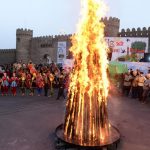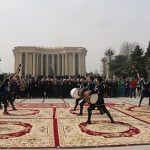By Lala Bagirzadeh
In Baku, conventional New Year’s celebration has taken place on the 31 December since the old Soviet days. And as such, the New Year holidays are hardly known for an abundance of snowfall or freezing cold weather. Perhaps, this “non-Christmassy” kind of weather might primarily affect kids during their winter school holidays. As for us, the adults are perfectly aware that, in keeping with true star almanac, the new year follows the vernal equinox, or more precisely, it happens on the night of 20-21March.It is at this point of time that Novruz comes into force to endow Azerbaijanis with unique, beautiful and profound meaning of the ancient spring festival with bright colors as the nature is awakened from its winter sleep. By the way, Novruz translates as “a new day”. Having overcome all thorny stages of Azerbaijan’s history, it has reached us from the depth of centuries as a rich heritage of ancestors. At times, the history of this bright holiday was uneasy since hostile Soviet atheists tried to ban Novruz as a Muslim religious holiday, albeit the holiday’s true origin is rooted in the era of Zoroastrianism. But celebration of Novruz never ceased in Azerbaijan. Though at different times it might have been celebrated in different ways and more or less modestly, time has shown that even a single candle light was enough to maintain our people’s love for this holiday, which it has carefully preserved for future generations. Having bypassed all ideological obstacles, this holiday survived till present day. On the 30th September 2009, Novruz was included in the UNESCO Representative List of the Intangible Cultural Heritage. Moreover, a resolution on “International Day of Novruz” was adopted under agenda item 49,”Cultureworld,” at the 64thsession of the UN General Assembly, held on 19 February 2010.
Foreign guests, whose number in our capital is increasing year by year, can easily eyewitness the fact that Novruz is admired both by Azerbaijanis and all the peoples populating our country, which is globally known for its tolerance. And it is no wonder, as people, no matter where in the world they live, always perceive the arrival of spring to be a period of renewal. In Azerbaijan, Novruz is annually expected with great excitement. Long before Novruz, people start making arrangement sand thoroughly clean their homes.
Tradition has it that window glass, chandeliers; light bulbs, tableware, silverware, mirrors, etc. must necessarily be polished so as to make the reflection of spring sunlight as bright as possible. Conventionally, this holiday is anteceded by several Tuesdays, called ‘last Tuesdays of the year.’ Having a profound meaning, each Tuesday is marked by a series of graphic festive rituals. And there should be no surprise, since one might rightfully say that the Orient is known for its delicacy. And now, we shall attempt to construe mysterious meanings of our festive rites for those in need of their interpretation.
Long before the holiday (Sometime in early March), every home primarily engages in preparing the major attribute of Novruz called ‘Semeni’ which embodies spring awakening, fertility and abundance of crops. For this purpose, a small amount of wheat grains is soaked and kept in water till they germinate and produce emerald clean sprouts by March 20 or 21, representing the arrival of spring and awakening of nature. It is desirable to repeat the words: “Take care of me, Semeni, and I will help you to bloom every year. “Some people may find this a bit trivial, but you can rest assured that the Azerbaijani people has, throughout the course of its history, repeatedly seen the true meaning of these words.On the days before Novruz, this vivid attribute can be seen and enjoyed in the homes of Azerbaijanis. Also, it is annually showcased from display windows of supermarkets, enjoyed at large shopping malls, restaurants, offices of international companies, beauty salons, etc. In short, it brings excitement everywhere where people have hope in the coming of Spring, believing this beautiful season of the year to become a happy outset of a new stage to come. And now, a few words shall be said about the mysterious Tuesdays, as our people have for centuries, linked every one of them with a certain natural phenomenon.
The first Tuesday is called “Su Chershenbesi” or the Tuesday of Water, as it symbolizes water, snowmelt and spring floods; the second one is entitled “Od Chershenbesi” or the Tuesday of Fire, as it symbolizes the power fire has to purge all negativity; third Tuesday is called “Yel Chershenbesi” or the Tuesday of Air that symbolizes wind and, finally, the fourth Tuesday’s name is “Torpag Chershenbesi,”symbolizing soil that is a waiting Spring transformation. On each of these four Tuesdays, gather around festive tables in their homes – in the light of bright holiday candles after the number of family members – to taste unparalleled oriental cookery, including Sheker Bura, Pahlava, Gogali, Badam Bura, Sheker Chorek, Sherbet, Sujuk, Halva, Bamia, dyed eggs and dry fruit: nuts, almond nut, pistachio, roasted wheat, rasins, dried apricot, persimmon, etc. It should be noted that many of these pastries symbolize specific things like, for example, Pahlava is shaped after rhombus symbolizing fire, Shor Gogal has a shape of circle or sun, Sheker Burais a symbol of crescent. People visit friends and receive guests on the feast day and prior to it, which is a centuries-long good tradition of Azerbaijani people. By the way, on Novruz days many people pay tribute to two ancient customs that may almost blow the minds of those that do not know their meaning. In keeping with the first custom, nobody can judge you for trying to eaves drop on your neighbors’ conversation on the last Tuesday. Do you know why? It is because our ancient ancestors used to say that the first thing somebody says behind a closed door shall determine the fate of the person that managed to overhear it. It is probably for this reason that anger, railing, lying and swearing in the home is prohibited both on the last Tuesday and other holidays, for disobedience to this tradition can cause one to invoke a personal disaster and, perhaps, even trouble someone else.
Another humorous tradition has endured for centuries to reach our day and age: on the evening of the last Tuesday, called “Bayram Akhshami,” a hat or small sack is placed on a threshold at the doors of the neighbors’ houses. People, mostly children, leave or throw them over a fence and hide. The householders should return the hats bountifully filled with holiday treats, according to ancient custom. At the first glance, this may just seem to be a funny joke, but the custom’s intent is for people to share the festive dainties with everyone who, for any reason, may need them. In the days of Novruz, joy must necessarily be bestowed on all people; no one should lack attention; it is important to have every home enjoy an atmosphere of celebration, goodness, plenty, sweets, smiles; children and elderly people must be made glad. It is no coincidence that on these days everyone is trying to congratulate their single relatives and friends, orphans, the sick ones, families of martyrs and all those who for various reasons cannot enjoy proper celebration of this holiday. For centuries, Azerbaijanis have adhered unto the tradition whereby, during this holiday season, people attended or phanages, boarding schools for children with various disabilities and nursing homes to provide them with gifts. To this day our people willingly perform this humane mission regardless of people’s faith and nationality. Novruz– a new day–should make all people happy and endow them with hope. During Novruz holidays, a groom’s family would send festive presents –in colorful trays called “Honcha” –for the prospective bride. This comprised a variety of gifts in the form of sweet delicacies, jewelry and dresses. The same trays, full with oriental sweet dainties, would always be returned by the bride’s parents to the groom’s home.
During the entire holiday period, and especially on the foregoing four Tuesdays, one might meet two major characters of Novruz, whose names are Kosa the beardless and Kechal the bald. They entertain people by reciting all kinds of jokes and sayings, performing funny skits right in the streets of Baku and throughout the country’s regions. While both singing and dancing for people, they also tell interesting stories about the history of this ancient holiday and people, usually, like to award these characters with oriental sweets.
No holiday is possible without Ashugs, Pehlavans(athletes), tightrope walkers, bold and dashing horsemen, cock fights and ancient national game called “Chovgan.”The unsurpassed skills of these champions, performing in the background of glowing fire, always complement the outdoor festivities in every region of our country. Since ancient times, mankind believed in the magical power of fire, including its ability to annihilate everything negative, including that conveyed through energy fields.
During Novruz holidays in Azerbaijan, people customarily jump over the fire seven times a sits flames are believed to be able to purge one from sin and burn away all their sickness and adversity. And you can be certain that it does not take long to find these brave people that can often be seen in city squares, parks and neighborhoods. But it is moral and ethical significance that provide most of this holiday’s fundamental value for our people. Thus, prior to the holiday, people do their best to pay off debts, refrain from lending out money, release the burden of old grudges, avoid quarrelling and never kill domestic animals.
It goes without saying that our people’s fervent adherence to these ancient observances must necessarily include paying tribute to those who forever went to their long rest. The day before the holiday, the Azerbaijani families necessarily visit cemeteries where, on the graves of their relatives and loved ones, they leave sweet sand offerings for the poor, ask mullah to read “Yasin” (sura of the Quran) and only then return home to sit at the banqueting table together with their family members.
The “Bayram Ahshamy” – evening of 20 to 21March – is considered the heart of Novruz holiday, according to the tradition. On this evening, every Azerbaijani family prepares a holiday pilaf –the main course of the feast, served with seven dishes, whose names start with letter “S” – accompanied with the entire range of oriental delicacies. These festive dishes and Honcha must be shared with people of other nationalities, according to a major custom.
In keeping with the eastern calendar, a period of visiting other people and/or receiving guests commences on the first day of the New Year and lasts for a number of subsequent days, when people hurry to visit their relatives, friends, acquaintances in order to congratulate and present them with festive gifts. On such days, children, the elderly, the sick and lonely people may never be left unattended. Thus, the ancient holiday of Novruz, by virtue of its glorious humane traditions, continues to unite people as it did many centuries ago by bringing representatives of various religious denominations closer to each other, calling every one of them to leave all resentments in the past in order to enter the new stage of their life with good intentions, enlightened heart and hope for the best.









